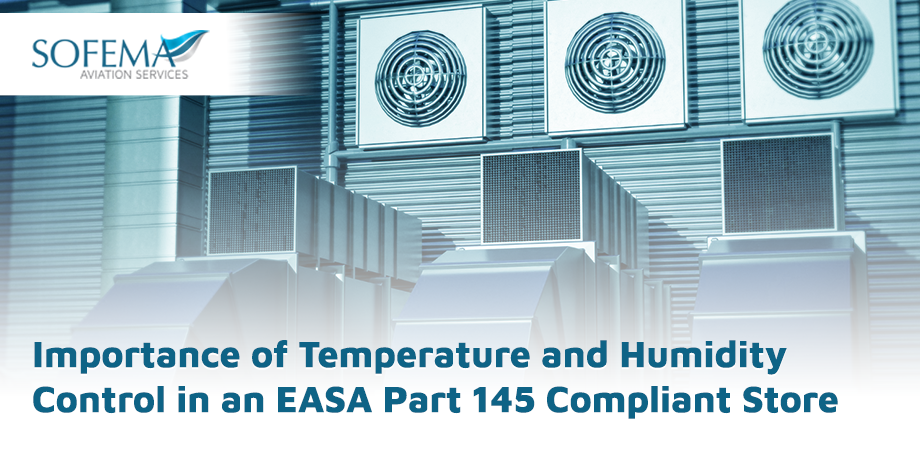Sofema Aviation Services (SAS) considers the regulatory requirements and best practices for managing and controlling temperature and humidity within approved storage facilities.
Introduction – EASA Part 145 Regulatory Requirements
EASA Part 145.A.25 Facility Requirements:
– Paragraph (d) of 145.A.25 states: “The working environment must be appropriate for the tasks being undertaken and shall ensure effective separation of activities to avoid cross-contamination. It shall also ensure protection from the weather elements. Special temperature, humidity, and cleanliness requirements must be observed when specified in the maintenance data.”
EASA Part 145.A.42 Acceptance of Components:
– Paragraph (a) of 145.A.42 emphasizes the need for proper storage conditions to prevent deterioration: “The organization shall establish procedures to ensure that only components in satisfactory condition and released on an EASA Form 1 or equivalent, as specified in 145.A.42(c), are installed. The organization shall ensure that components are stored and handled following the manufacturer’s instructions and in a manner that prevents damage and deterioration.”
EASA AMC 145.A.25(d) to Part 145:
– The Acceptable Means of Compliance (AMC) to 145.A.25(d) provides additional guidance: “The working environment should be such that the effectiveness of personnel is not impaired. Temperature and humidity control should be appropriate to the different work types (e.g., avionics, painting, etc.).”
Key Points:
• Temperature and Humidity Control: The regulation and the AMC stress the importance of controlling temperature and humidity to ensure that parts and materials are stored in conditions that prevent deterioration.
• Manufacturer’s Instructions: The regulation mandates adherence to the manufacturer’s instructions regarding storage conditions, which often specify the required temperature and humidity ranges.
• Separation of Activities: Effective separation of activities and protection from environmental elements are emphasized to avoid cross-contamination and ensure the quality and safety of aircraft components.
While these regulations ensure that EASA Part 145 organizations maintain high standards of storage conditions, preserving the integrity and functionality of aircraft parts and materials, organizations typically develop detailed internal procedures based on these regulatory requirements and the specific needs of the parts they handle.
Maintaining Strict Control over Temperature and Humidity:
- Corrosion of Metal Components: High humidity levels can lead to oxidation and corrosion, compromising aircraft components’ structural integrity and functionality.
- Damage to Sensitive Electronic Components: Moisture can cause malfunctions and failures in sensitive electronic components.
- Degradation of Composite Materials: Temperature fluctuations and high humidity can weaken composite materials.
- Deterioration of Rubber and Plastic Components: Unsuitable environmental conditions can lead to leaks and mechanical failures in rubber and plastic parts.
- Avoidance of Mold and Mildew: Humid environments can promote the growth of mould and mildew, damaging materials and posing health risks to personnel.
- Warranty and Compliance: Many manufacturers specify storage conditions for their parts. Non-compliance can void warranties and result in regulatory violations.
- Extended Shelf Life: Proper environmental control can extend the shelf life of stored parts, reducing waste and ensuring parts are fit for use when needed.
Optimum Conditions:
- Temperature: The recommended storage temperature for most aviation parts is between 15°C and 25°C (59°F and 77°F). Avoid extreme temperatures.
- Humidity: The ideal relative humidity level should be between 35% and 55%. Levels above 60% can accelerate corrosion and mould growth, while very low humidity can cause brittleness in some materials.
Monitoring and Recording Data:
- Use calibrated sensors to monitor temperature and humidity levels within the store continuously.
- Install data loggers to record environmental conditions at regular intervals (e.g., every 30 minutes).
- Conduct regular audits to ensure that the monitoring equipment functions correctly and that recorded data is accurate.
- Implement an alert system to notify personnel of significant deviations from the environmental parameters, allowing immediate corrective actions.
Next Steps
Sofema Aviation Services & Sofema Online provides Classroom, Webinar and Online EASA Compliant Logistics Training. Please see the websites or email team@sassofia.com
June is dedicated to Aviation Stores and Logistics аt Sofema.
Discover our ongoing campaign and benefit from special discounts -20% off on Aviation Stores and Logistics courses until June 2024. See the details
Join our exclusive FREE workshop webinar and engage with industry experts Don’t miss the chance to ask your questions and discuss them during the workshop. Sign up here.
Tags:
EASA Part 145, Logistics, SAS blogs, best practices, Aviation Stores and Logistics, Humidity Control, Temperature and Humidity, Temperature Control, Storage Facilities, Monitoring Data, Recording Data





